Pixfra Volans V850 LRF Review: A Smart Digital Day/Night Scope
- Last updated: 03/10/2025
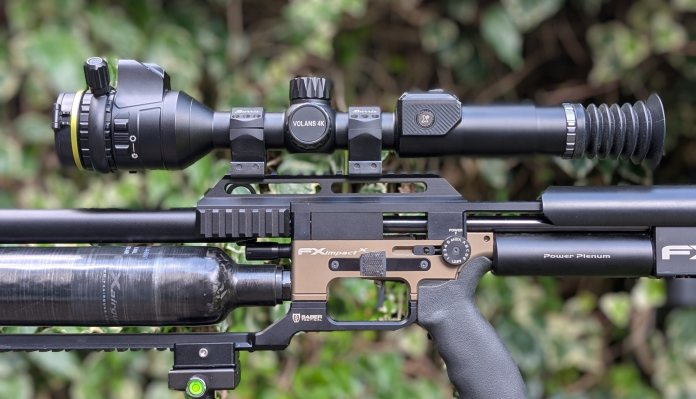
A good digital riflescope is becoming a must-have for any serious hunter. In the crucial twilight hours at dawn and dusk, digital scopes give a clearer image than the most expensive conventional optics, and when complemented by a quality IR illuminator, they produce impressive results, imaging quarry crisply well beyond normal hunting ranges, outdoing old-school tubed NV, and providing more conclusive identification than their thermal counterparts. The latest generation are impressive performers by day as well, offering sharp imaging, nuanced colours, and ample magnification.
Naturally, their versatility has a digital dimension too, giving you a wide range of reticle designs and colours to choose from, as well as multiple monochrome options for night work: from basic black-and-white to green, sepia, and violet.
Better still, models with integrated rangefinders can be programmed with ballistic profiles configured to the performance of your rifle and load. This facility enables them to deliver precise drop compensation at the touch of a button, allowing you to make consistently effective kills with such popular, if loopy options as subsonic .22LR and sub-12ft/lb .22 air at previously unreachable distances.
The programmability of digital riflescopes also means that you can set them up under conditions of your choosing, using a convenient smartphone interface, so that everything is just as you want it before you start to hunt, thereby simplifying field use compared with a feature-laden analogue scope.
We can add two further benefits to this list. The first is the ability to record images, especially video. As well as letting you record successful shots, video can be a practical asset for recovering shot game, as it can capture key details that a hunter might miss in the heat of the moment, such as how an animal reacts to the strike, which way it runs, or where it falls, even augmenting the information in the picture with range and compass direction data from the on-screen display.
The second is cost. To begin with, 4K digital scopes do not require the complex assemblage of precision-machined components and carefully ground, multi-coated lenses that a variable-power analogue riflescope demands. Consequently, digital scopes are priced in the high hundreds, while comparable functionality in an analogue day scope increasingly means paying several thousand. Moreover, because electronics are central to their design, digital scopes readily integrate the functions of low-light sensing, laser rangefinding, ballistic compensation, and recording outlined above, which would be cumbersome and costly bolt-ons for a conventional scope.
As hunters come to recognise the power, versatility, and value of digital scopes, for daytime as well as night-time use, the market is expanding, and with it, the choices available. In the UK, Pard was arguably the pioneer, HikMicro became the benchmark, and now Pixfra is claiming its slice of the action with the new Volans.
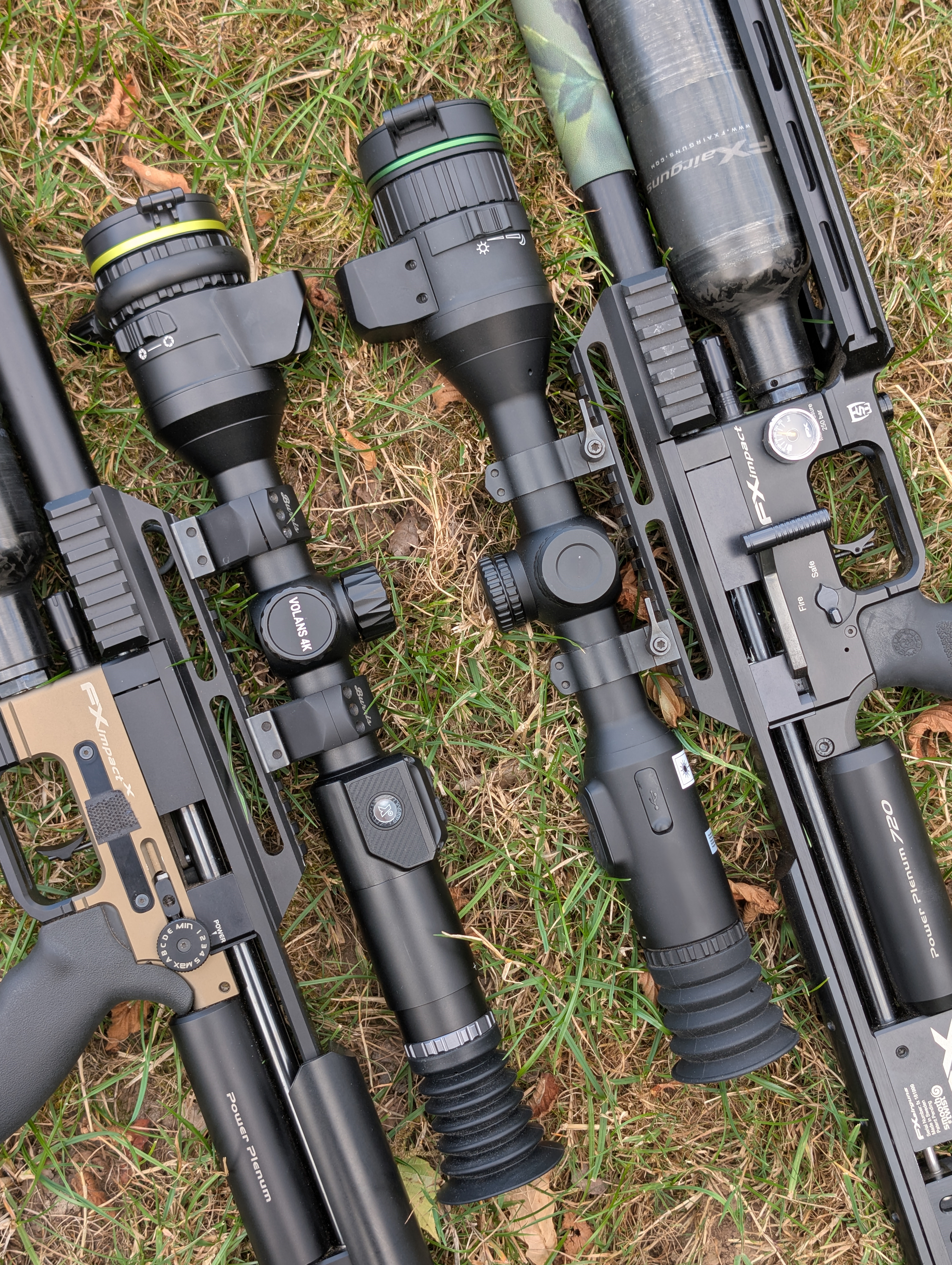
A side-by-side comparison shows how the Volans measures up to its principal rival.
The Volans makes a very positive first impression, with a tough anodised metal body, a neatly profiled rangefinder housing, and signature accents of lime and carbon-fibre. It has “presence”, too, measuring 434.3 x 86.8 x 86.9mm and weighing 1,040g, which is still a smidgen less than its competitors.
The controls are intuitive and well distributed around the scope. Analogue controls include the usual rings around the objective and ocular bells for focusing the target image, and the display, respectively, both of which were smooth and “goldilocks” tight. In a typically smart move that marries minimal expense to maximum benefit, Pixfra provides the Volans with a “coaster”, a twist-locking knob that can be positioned exactly where you want it around the objective bell to provide fast target focus.

The laser module sits discreetly above the large 50mm objective, which has a sturdy hinged cover with a secure latch.
Less welcome is the telescopic dioptre adjustment, as each turn moves the ring rearwards, eating into the 70mm eye relief. The soft rubber buffer is therefore a reassuring feature for centrefire users.
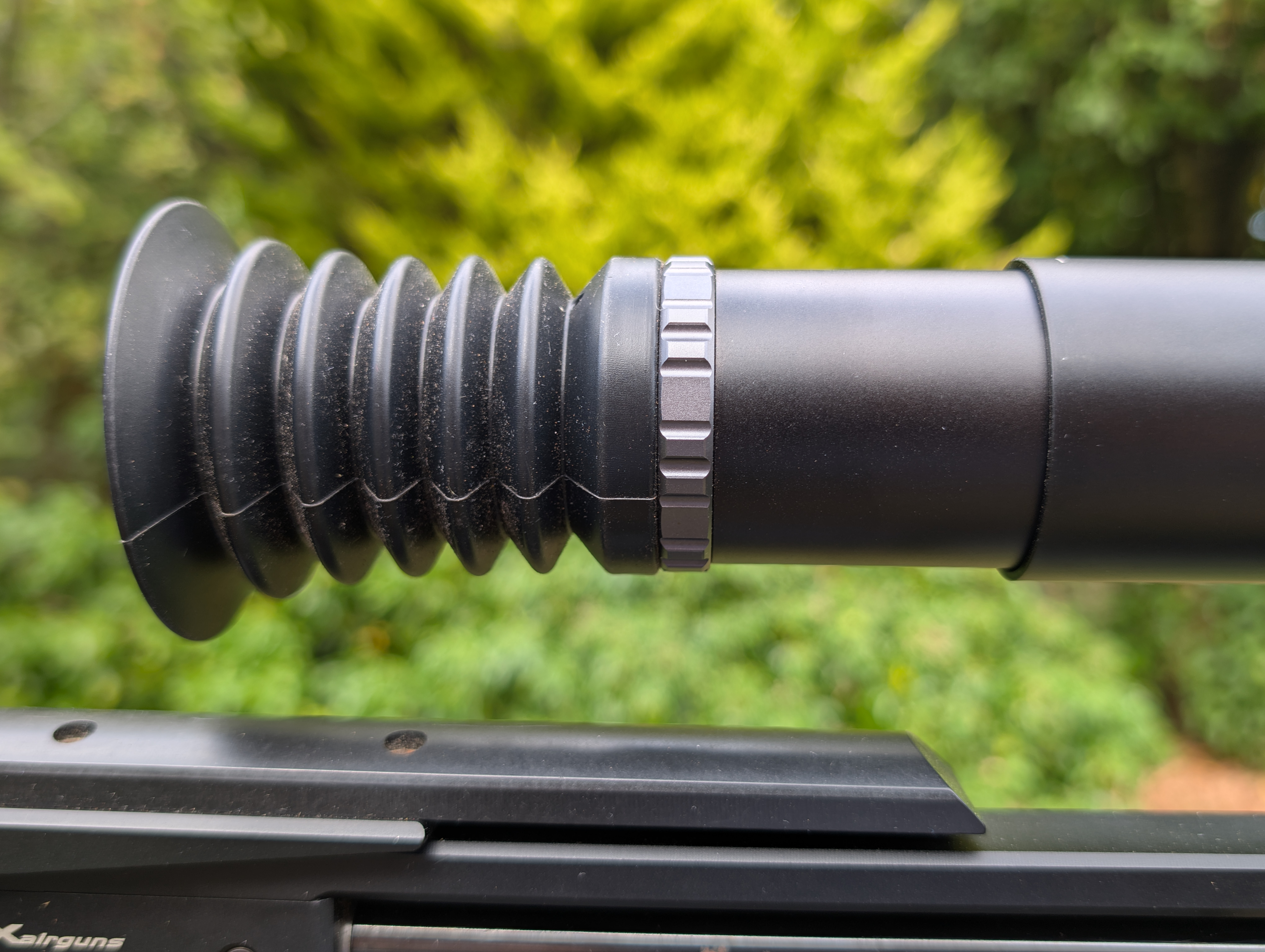
The dioptre adjustment is telescopic, so the more you need, the longer the Volans gets, shown here at full extension.
A third control is special to the Volans. It consists of a slide on the left-hand side of the objective bell that switches the aperture between f1.2 and f3.0. This has four major benefits: two by day, and two by night. By day, switching to the smaller aperture reduces the amount of light entering the scope, effectively providing a second set of exposure settings calibrated for intense light; meanwhile, switching to the larger aperture reduces the depth of field, allowing you to focus precisely on your target. By night, selecting the larger aperture lets in more light, optimising the performance of the scope’s low-light sensor, while in twilight, it lets the scope keep delivering a usable colour image well beyond the limits of conventional optics, let alone the human eye.
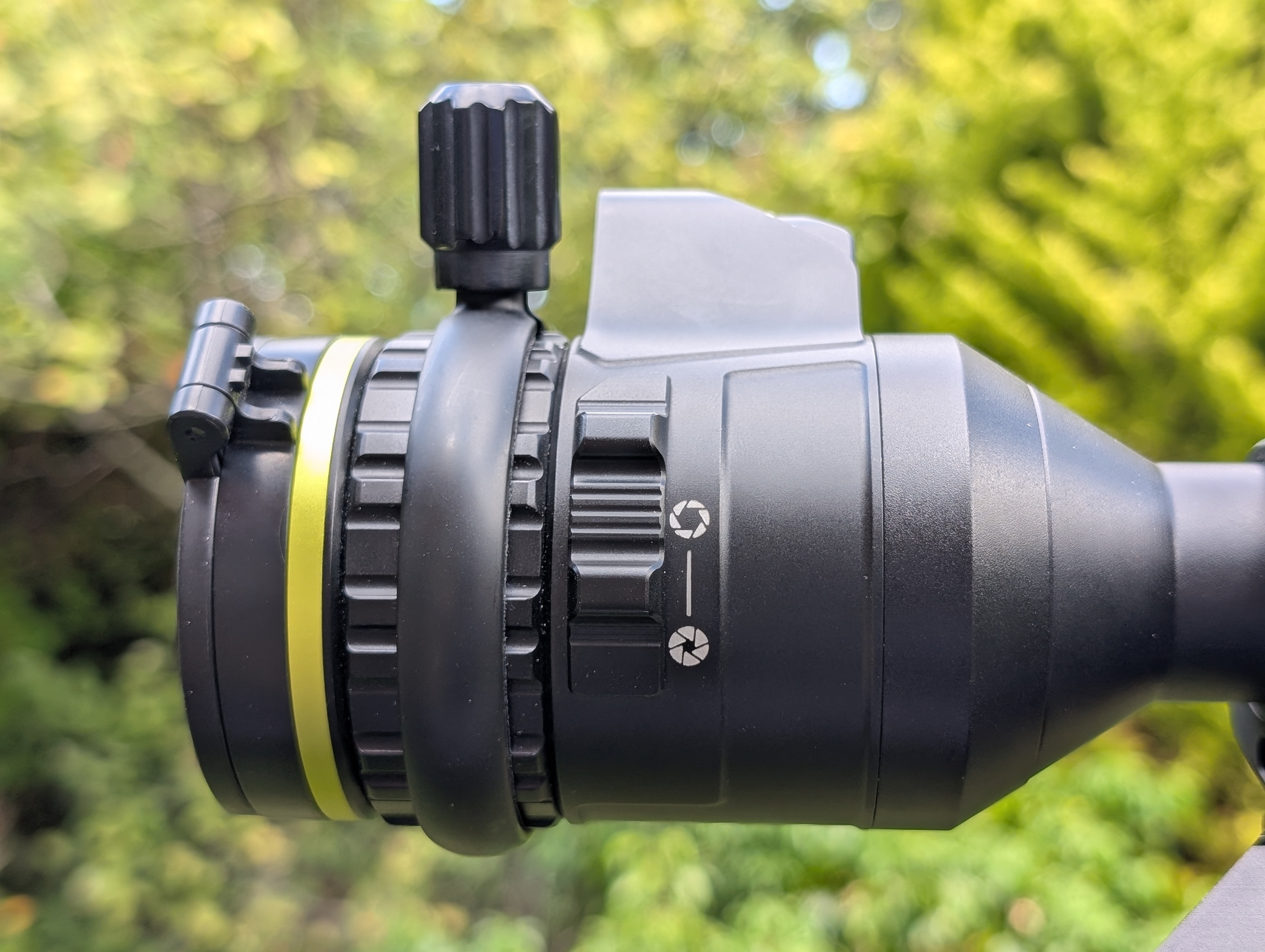
A sliding switch on the objective bell changes the aperture, allowing the Volans to perform optimally in a wider range of light conditions.
The switch can also be used to supplement Pixfra’s “Smart IR” function, which combats the “white-out” effect caused when an IR illuminator over-illuminates nearby objects by automatically adjusting the Volans’ exposure levels. It functions so well under IR that you’ll barely notice its interventions, so to appreciate its responsiveness, simply activate it by day, and observe how “twitchy” the exposure becomes!
Our next set of controls is on the ocular bell and covers all the things you want to access quickly in the field. Three rubberised buttons enable rangefinding/PiP, still/video capture, and scene mode (colour for daylight use, and black-and-white, green, or sepia for use in low light and under IR). They are easy to locate, differentiate, and remember.

Three buttons on the ocular bell handle image capture, ranging, and scene (palette) selection.
On the left-hand side is a smart, branded power button with optional illumination, incorporating a power-saving standby function. On the right-hand side is a USB-C port, protected by a rubber cover, that permits data transfer and the use of an external power bank.

The USB-C port lets you hook up a power bank and transfer data. Wi-Fi is also available.
Between the objective and ocular bells, the Volans has a 30mm main tube for compatibility with all mounting systems, and I found there was enough space on either side of the saddle to get it comfortably set up with a simple, yet chunky, set of tactical rings, while still leaving room to mount an aftermarket IR illuminator. As usual with digital and thermal scopes with this form factor, the saddle itself houses a removable, rechargeable 3,200mAh battery in a transverse compartment. The cap, however, is unusually good, locking securely yet opening easily. Also unusual is the absence of an internal battery, which is a smart move since fixed batteries add weight and cost, while compromising the unit’s longevity. Each 18650 provides around five hours of run time, and with two supplied, you’re well covered.
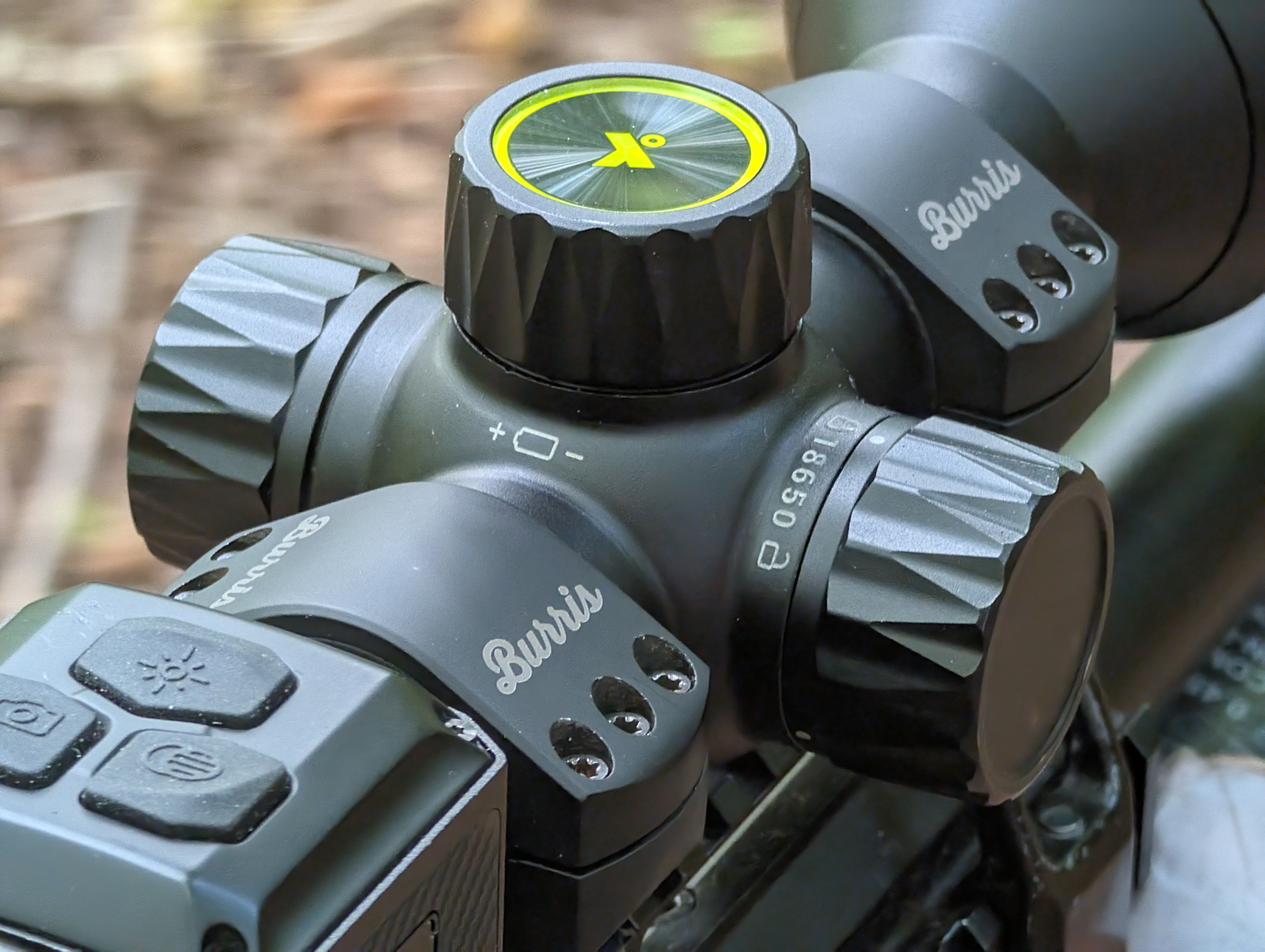
The saddle houses the rechargeable, removable 18650 battery and supports an intuitive, multifunction, turn-and-click controller.
On top of the saddle is a familiar turn-and-click knob. Just turn it to zoom in or out. Base magnification is 4.3x, but it feels higher, perhaps due to a tight-ish field of view of 8.6m @ 100m. I’m very “less-is-more” about magnification, but for those who love it, the Volans will take you digitally all the way to 39x, while applying sophisticated AI to smooth out the pixelation as you go.

With PiP activated, zooming in enlarges the image in the PiP window, which shows only an indicative reticle.
Clicking, meanwhile, will put you into the menus, where you can tweak settings to your heart’s content. The essentials here are zeroing and ballistic programming. The former uses the super-simple shoot-freeze-adjust-save-confirm process. It’s easy to do on the scope, and even easier when you adjust the point of impact using the interface on Pixfra’s smartphone app. The app is also ideal for entering the data to create a ballistic profile. The Volans has room for five, dedicated to different loads and rifles. Unfortunately, these are only alphanumeric, with no naming option, but Pixfra is responsive to feedback, so future firmware should fix this. I should note here that Pixfra keeps raising the bar with the clarity of its icons, menus, and on-screen displays.
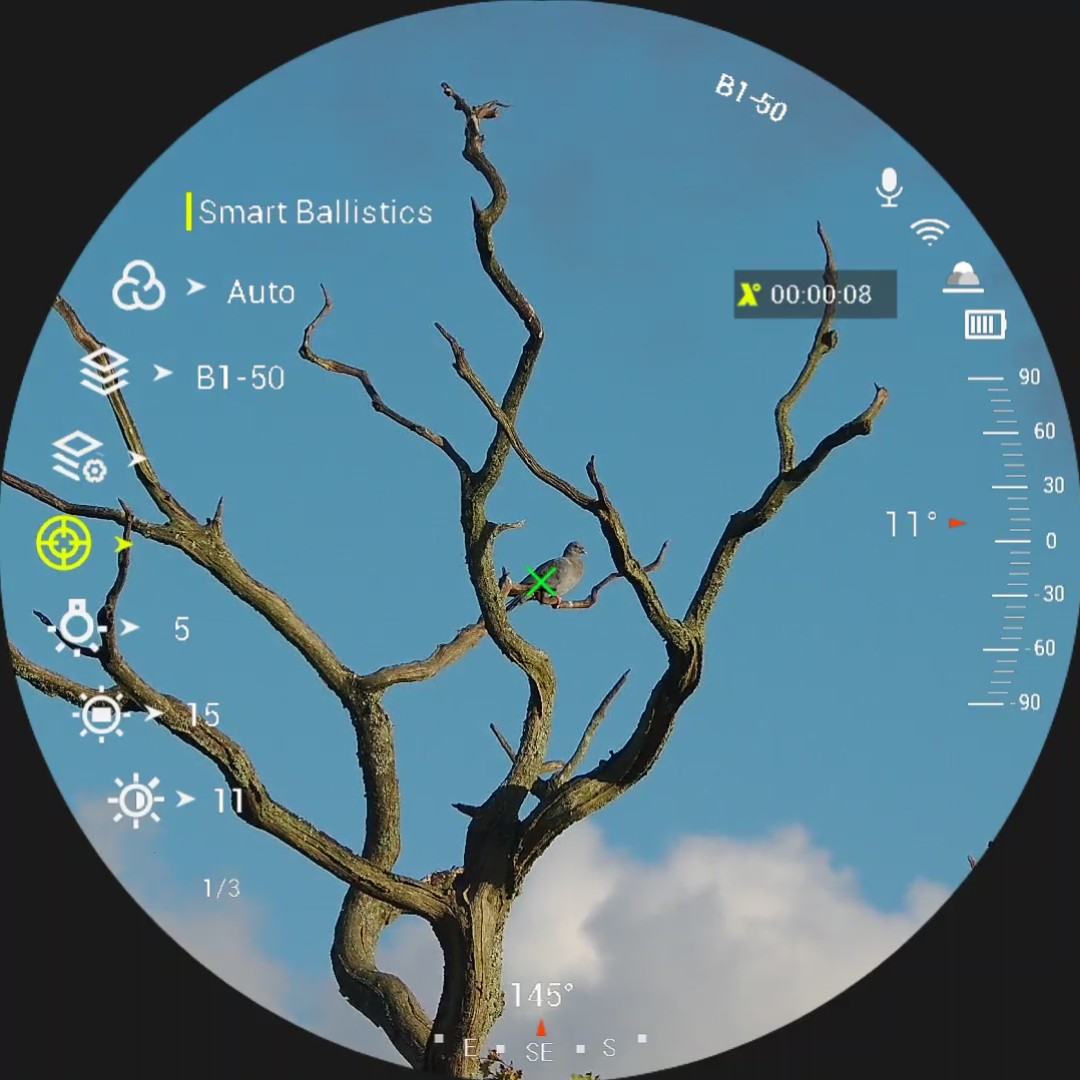
The icons are well-sized, clearly labelled, and neatly arranged around the circumference of the display.
With a profile set up and selected, ranging the target will initiate a trajectory calculation and generate a secondary aiming point. As well as allowing precise shots at longer ranges, it’s a huge asset when taking shots at steep angles or at very close range, which is a frequent and tricky challenge when tackling squirrels, ferals, and rats with an air rifle. The system proved very effective, but I would have liked a choice of aiming point designs. For example, a horizontal bar would make windage adjustments easier. Another niggle was that the recoil-activated auto-record function didn’t work reliably on airguns or rimfires. It would be nice to be able to tweak it for sensitivity or to have an audio-based alternative.
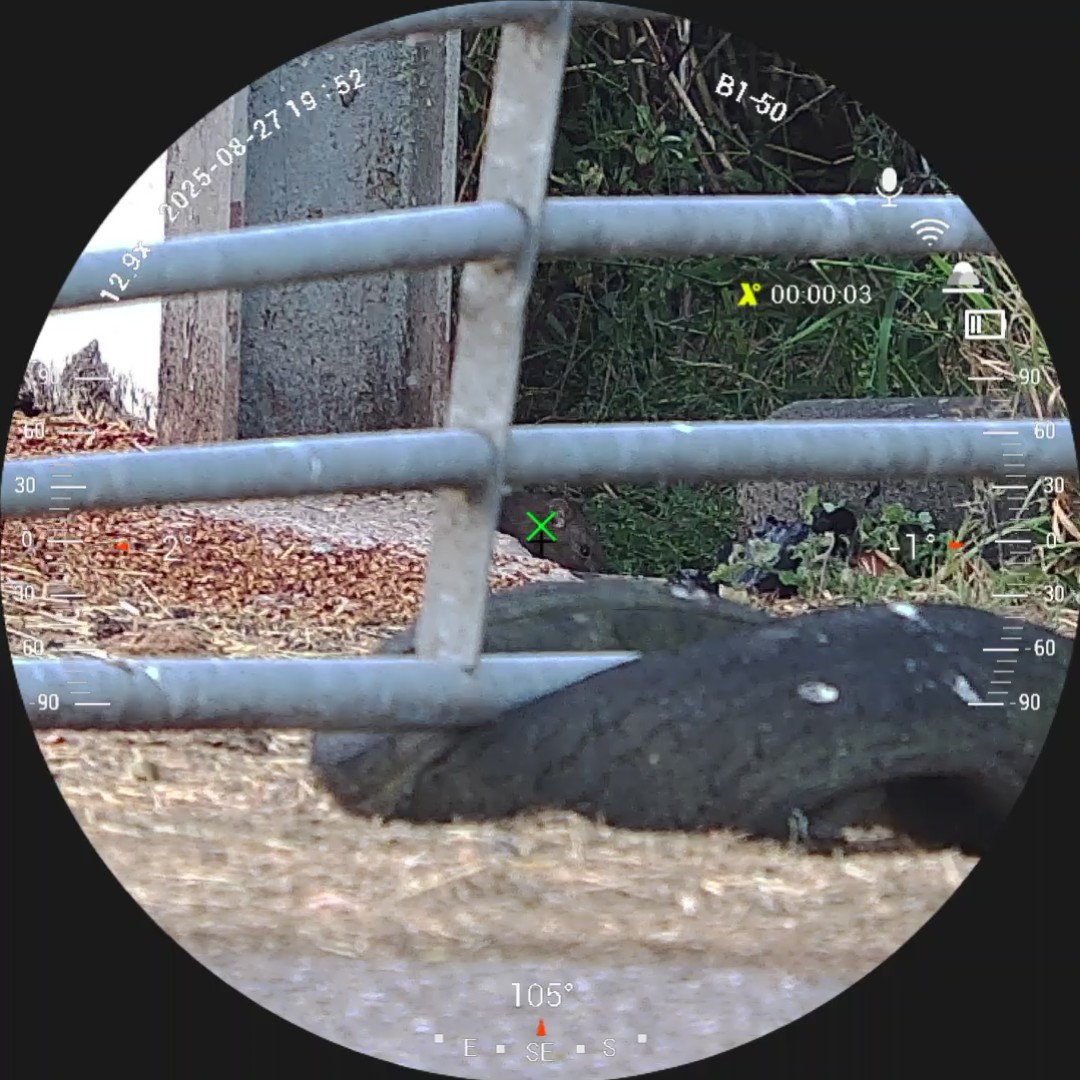
Having ranged this rat, the Volans has positioned the green secondary aiming point a fraction above the black reticle, ensuring a precise strike.
Regarding visual performance, the Volans performed very well, but I found its specification puzzling. The sensor is a big 3840x2160 (4K) item, yet the display is just an 800x800 LCD. This delays the rate at which the image loses detail as you zoom in, but it also means you never get a full 4K experience. Indeed, even video files are compressed to 1080x1080. The circular display looks good and remains flat and even right to the edges, but its shape crops the extra horizontal field of view (FOV) that a rectangular display would deliver, along with the useful information it would add.
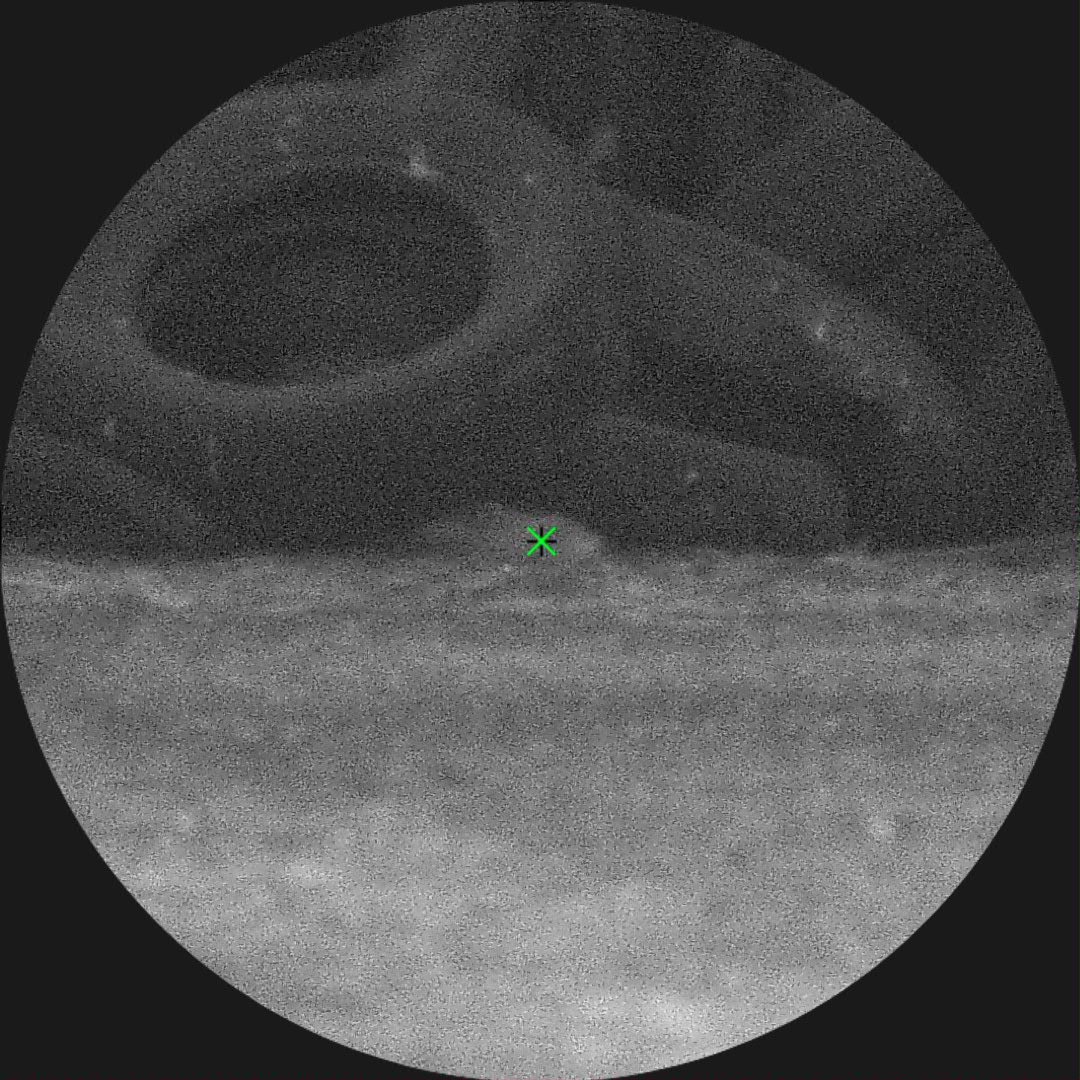
The scene button lets you choose the best palette in low-light conditions.
Overall, the Volans deserves serious consideration. It is well made, easy to use, and delivers smart, versatile, detailed imaging at an appealing price (£789.95). There are some shortcomings, but most can be fixed through firmware, and the remainder are somewhat subjective. An impressive debut.